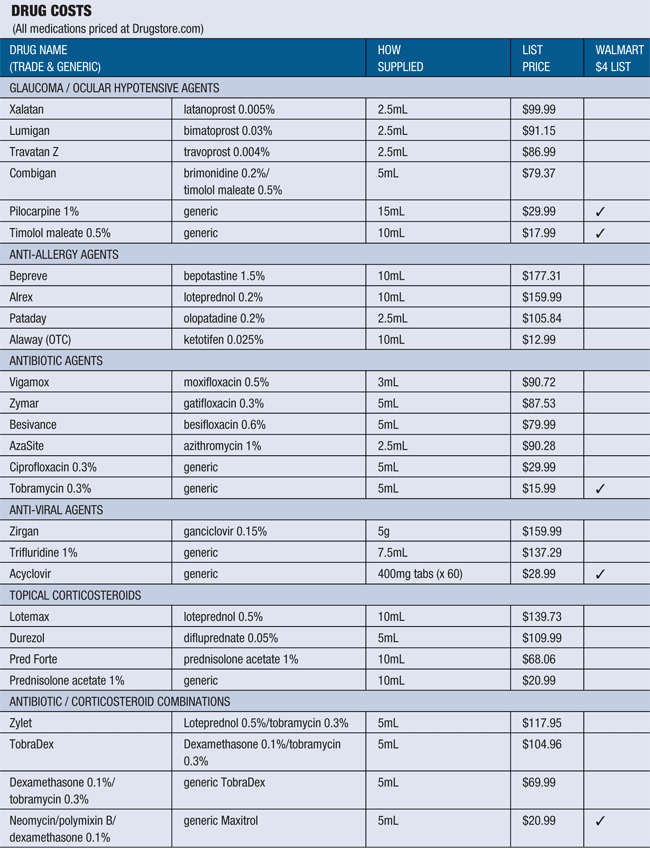Today’s medications can be quite costly, especially here in the United States. In optometry––as in much of medicine––proper patient care critically depends on adherence to the prescribed course of therapy. But, what do we do if patients simply cannot afford to purchase the drugs that they so desperately require?

The Standard of Care
In each form of ocular disease, there is a “standard of care” that dictates which type of medication we select as our first-line therapy. Usually, it is not a single drug, but one agent from a family or class of drugs that is the preferred choice of most physicians. The standard of care––or “gold standard”––is most commonly the drug that offers the greatest efficacy with the least potential for adverse events, as well as the greatest likelihood for adherence.
In glaucoma management, for example, the initial drug of choice to lower IOP typically is a prostaglandin analog, such as travoprost, bimatoprost or latanoprost. Or, for anti-infective therapy, we tend to select a later-generation fluoroquinolone, such as moxifloxacin, besifloxacin or gatifloxacin.
But, there is quite literally a high price to pay for the newest, best and most convenient therapy. And, when patients cannot meet that price, it unfortunately becomes the practitioner’s task to find another means of treating the disease.
Patient Assistance
Fortunately, most of the larger drug companies offer patient assistance programs to help low-income individuals meet the soaring costs of therapy. All physicians should register with a website called RxHope (
www.rxhope.com) for their economically challenged patients. RxHope provides a central clearinghouse for most major pharmaceuticals, including ocular medications from companies such as Alcon, Allergan, Bausch + Lomb, Genentech, Merck, Ocusoft and Pfizer.
By entering your contact and licensure information as well as some basic facts about the patient, RxHope can create and complete an online form for each individual company and drug request; this, in turn, can be printed, signed and sent to the company for processing.
Be aware that each pharmaceutical company establishes its own guidelines and manages its own individual assistance program. Therefore, the requirements, ease of use and processing time can vary substantially. Of course, most companies require that the patient be a United States citizen and have no other prescription coverage, including Medicaid or
Medicare Part D, and that their annual income is at or below 200% of the current Federal Poverty Level.1 (For an individual, this translates to less than $21,660 per year.)2 Most plans also require patients to submit documentation affirming these stipulations.
Despite its limitations, RxHope provides a relatively quick and easy method for determining which drugs are available through patient assistance programs, and helps to facilitate these requests for our patients.
Pharmaceutical Options
If a patient fails to qualify for assistance, or if the drug is immediately necessary for acute care, then you must resort to other methods. Depending on the particular disease state, there are often cost effective medications that can help achieve similar outcomes as the gold standard drugs.
Let’s examine each of these drug classes in turn:
• Glaucoma. Glaucoma management is one of the most substantial economic burdens in eye care. By its very nature, glaucoma necessitates chronic, ongoing therapy, and patients often require two or more agents to maintain IOP control.
The most expensive drugs per unit cost are the prostaglandin analogs, which also are the most frequently prescribed glaucoma drugs. Xalatan (latanoprost 0.005%, Pfizer), Lumigan (bimatoprost 0.03%, Allergan) and Travatan Z (travoprost 0.004%, Alcon) are comparably priced between $90 and $100. The prostaglandin analogs are extremely effective and have been shown to lower IOP by as much as 35%.3
Combigan (brimonidine 0.2%/timolol maleate 0.5%, Allergan), which combines two drugs in the same bottle, is actually a bit less expensive than the prostaglandin analogs. Of course,
Combigan must be used twice daily and may be contraindicated in patients who use systemic beta-blockers.4
The least expensive options for glaucoma therapy include generic pilocarpine 1% and timolol maleate 0.5%, which both cost less than $30 per bottle (a 5ml of generic timolol can cost as little as $4). While these generic medications may not be as efficacious or convenient as prostaglandin analogs and have more side effects, these agents can be used to effectively maintain target IOP in many patients with limited finances.
• Allergy. While ocular allergy rarely is a sight-threatening condition, many patients experience regular symptoms of itching, swelling and tearing of the eyes that can significantly compromise their quality of life.5 The most common therapies for ocular allergy involve multi-action drugs that have the capacity to stabilize mast cells and block histamine receptors.
Bepreve (bepotastine 1.5%, ISTA) and Pataday (olopatadine 0.2%, Alcon) are the newest and most widely used agents in this family. Not surprisingly, they are also the most expensive, at roughly $100 per month of therapy.
By comparison, Alaway (ketotifen 0.025%, Bausch + Lomb) has similar properties as Bepreve and Pataday, and costs less than $15 per bottle. Moreover, Alaway is available without a prescription.
• Antibiotics. Topical antibiotics are usually prescribed for acute infections, such as bacterial conjunctivitis or keratitis, and may also be used prophylactically for injuries or perisurgical management. The fluoroquinolones are the newest and most commonly prescribed agents in this category. The three leading drugs include Zymar (gatifloxacin 0.3%, Allergan), Vigamox (moxifloxacin 0.5%, Alcon) and Besivance (besifloxacin 0.6%, Bausch + Lomb); all range between $80 and $95 per bottle. AzaSite (azithromycin 1%, Inspire) is not a fluoroquinolone, but it is priced comparably and can be preferable for some patients because of its less frequent dosing regimen.
Still, older fluoroquinolones and aminoglycosides can be more cost effective. Be aware, however, that these agents have a far greater potential for bacterial resistance and local toxicity, and also require more frequent dosing. But, in most cases, older agents will still do the job.
• Antiviral agents. Treating herpetic keratitis requires prompt intervention to prevent corneal scarring. Currently, there are two FDA-approved therapies: Zirgan (ganciclovir 0.15%, Bausch + Lomb) and generic trifluridine 1%. Both medications cost in excess of $125 for a course of therapy. In contrast, herpes simplex keratitis can be managed effectively and more economically with oral acyclovir, 400mg five times daily for seven to 10 days.6
• Corticosteroids. Corticosteroids are crucial for the management of inflammatory ocular conditions, especially uveitis. The most commonly prescribed agents in this category are Lotemax (loteprednol etabonate 0.5%, Bausch + Lomb) and Pred Forte (prednisolone acetate 1%, Allergan). The newest addition to this category is Durezol (difluprednate 0.05%, Alcon). These three drugs range from $65 to as much as $140 for a course of treatment.
A less expensive option is generic prednisolone acetate, which can be obtained for less than $25 per bottle. However, when using generic prednisolone suspension, patients must be advised to shake the bottle vigorously for at least one minute in order to obtain the correct drug concentration in each drop.7
• Antibiotic/corticosteroid combinations. These agents are used for a wide range of ocular conditions, such as blepharoconjunctivitis, corneal phlyctenule, contact lens-associated red eye and even shield ulcers associated with vernal keratoconjunctivitis. The most common drugs are Zylet (loteprednol 0.5%/tobramycin 0.3%, Bausch + Lomb) and TobraDex (dexamethasone 0.1%/tobramycin 0.3%, Alcon), which can cost upwards of $100 for a 5mL bottle. Generic TobraDex is about two-thirds the cost, while generic Maxitrol (neomycin/polymixin B/dexamethasone 0.1%) is less than $25 for the same volume.
As the old adage goes, “you get what you pay for.” Patients need to understand that less expensive options may have some significant drawbacks over newer, more popular agents.
But, for those patients who just can’t afford top-shelf drugs, it is important to offer alternatives that can provide at least some measure of therapeutic efficacy.
Dr. Kabat is a consultant to Alcon, Inspire and ISTA Pharmaceuticals. Dr. Sowka is a consultant for Alcon. Neither author has any direct financial interest in any of the products mentioned.
1. Patient Assistance Programs. RxHope. Available at:
www.rxhope.com (Accessed August 28, 2010).
2. U.S. Department of Health & Human Services. 2009 Federal Poverty Guidelines. Available at: http://aspe.hhs.gov/poverty/09poverty.shtml (Accessed August 28, 2010).
3. Aptel F, Cucherat M, Denis P. Efficacy and tolerability of prostaglandin analogs: a meta-analysis of randomized controlled clinical trials. J Glaucoma. 2008 Dec;17(8):667-73.
4. Allergan, Inc. Combigan package insert, 2008.
5. Palmares J, Delgado L, Cidade M, et al. Allergic conjunctivitis: a national cross-sectional study of clinical characteristics and quality of life. Eur J Ophthalmol. 2010 Mar-Apr;20(2):257-64.
6. Guess S, Stone DU, Chodosh J. Evidence-based treatment of herpes simplex virus keratitis: a systematic review. Ocul Surf. 2007 Jul;5(3):240-50.
7. Fiscella RG, Jensen M, Van Dyck G. Generic prednisolone suspension substitution. Arch Ophthalmol. 1998 May;116(5):703.


